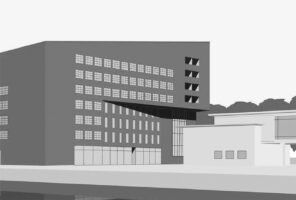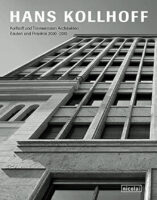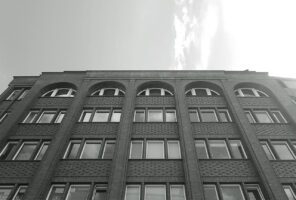The Pain Threshold of Architecture
Book review Hans Kollhoff, Kollhoff und Timmermann Architekten, Bauten und Projekte 2000-2015, published in: De Architect, 2016
 There are people who insist that recent Dutch architecture can be divided into two periods: a period before the completion of Hans Kollhoff’s Piraeus building in 1994 and a period after that. This assumption, for example, is the base of Jan Peter Wingender’s book ‘Brick, an Exacting Material’ in which he investigates the relationship between the technical and architectural merits of a range of domestic buildings of the post-Pireaus era. He implicitly asks how the Dutch have taken up the gauntlet that Kollhoff threw at them in 1994.
There are people who insist that recent Dutch architecture can be divided into two periods: a period before the completion of Hans Kollhoff’s Piraeus building in 1994 and a period after that. This assumption, for example, is the base of Jan Peter Wingender’s book ‘Brick, an Exacting Material’ in which he investigates the relationship between the technical and architectural merits of a range of domestic buildings of the post-Pireaus era. He implicitly asks how the Dutch have taken up the gauntlet that Kollhoff threw at them in 1994.
Now Kollhoff himself speaks about this period. The latest monograph on the work of Hans Kollhoff and his partner Helga Timmermann is heavier than a telephone book. Yet, the book presents just a fraction of his portfolio and does not use one word or image too many. The size of the book enables the reader to concentrate on the drawings, photographs and texts. The images are large and placed symmetrically on the pages. Sometimes the architectural idea and the built object, the drawing and the photograph, are placed directly opposite to each other. The cover shows a detail photograph of an urban block in Cologne where the stone facades of a historic corner building have been integrated in the new buildings designed by Kollhoff. The façade geometry of the new build is accurately adjusted to that of the monument, by which an amount of apparent freedom was generated in the choice of materials, the proportions and the volumetric development of the new ensemble. The merciless precision of the image shoves the reader’s nose into the facts. This book is about solidity, the architectural detail, the appreciation of existing urban architecture and the contemporary, accurately joining of the old and the new.
 The introductory text is written by Jan Büchsenschuß who adequately summarizes the themes of the designer. If Kollhoff talks about the classical in architecture, then he means connotations like perfect, proven and timeless. ‘The classical, so defines Kollhoff, is the quintessence of the architectonic, which bears an infinite morphological variety and which sets itself to reach excellence through discovery and refinement.’ Büchsenschuß leaves it to the theorist Fritz Neumeyer to memorize the loss of symbolic power within current façade design practice. Those façades that are assembled by sub-contractors under strict regulations, back-to-back guarantees and quality certificates are nevertheless mute and anonymous and force designers to embark on sculptural exercises. The price paid, according to this belief, is the loss of coherence of the street façade and ultimately the quality decrease of urban life. It is Neumeyer again who argues that the silver thread in Kollhoff’s work is the ambition to bring together again the worlds of theory and praxis which have drifted apart so dramatically.
The introductory text is written by Jan Büchsenschuß who adequately summarizes the themes of the designer. If Kollhoff talks about the classical in architecture, then he means connotations like perfect, proven and timeless. ‘The classical, so defines Kollhoff, is the quintessence of the architectonic, which bears an infinite morphological variety and which sets itself to reach excellence through discovery and refinement.’ Büchsenschuß leaves it to the theorist Fritz Neumeyer to memorize the loss of symbolic power within current façade design practice. Those façades that are assembled by sub-contractors under strict regulations, back-to-back guarantees and quality certificates are nevertheless mute and anonymous and force designers to embark on sculptural exercises. The price paid, according to this belief, is the loss of coherence of the street façade and ultimately the quality decrease of urban life. It is Neumeyer again who argues that the silver thread in Kollhoff’s work is the ambition to bring together again the worlds of theory and praxis which have drifted apart so dramatically.
Most of the book is reserved for the presentation of projects . The annotations are by Hans Kollhoff who makes no attempt to explain the projects objectively. The texts are varied in tone and structure. Jargon is lacking. Understated and sometimes ironic, he writes about the context in which his designs function, for example the domestic ensemble at the Rotterdam Laan op Zuid: ‘Our first concern was to stipulate architectonic quality beyond the short half-life values of the commercial imagery – within the Dutch housing industry that has been optimised up to the pain threshold.’
Like every barrier, this pain threshold separates different domains. There is the domain of architecture and that of the context which defines architecture. The design is part of neither: the design is that barrier. With all his attention to the contextual conditions the monograph convincingly demonstrates that Kollhoff does not see a reconciling or mediating role for the design. The design puts the relation between the two worlds at an edge. After all, the classical is a strive for excellence.

That attitude results in very different designs. In Hamburg, Kollhoff transformed a steel office building from the 1950s into a reinforced concrete frame with heavy facades that reference local architecture with brick and terra cotta decorations. For a business park near Stuttgart (arguably a non-place), he designed a showroom for Mercedes-Benz which features floors that spiral upwards and boasts glass facades. A jewellery shop in Munich received a meticulously designed interior with quasi-antique carpentry. The designs are agile in their social and physical contexts. The author moves confidently in the architectural canon – mostly laconic, sometimes humorous, occasionally experimenting with the rules of the trade. Those who should argue that Kollhoff plays this game with playful ease overlook the fact that his designs are not without obligations. They are firm, perhaps uncomfortable and for some even painful, statements about the excellence befitting the modern age. Where does this idealism come from?
One answer can be found in the article ‘Citadini’ Kollhoff published in Domus. ‘Until now I have ascribed the development of the European city almost exclusively to the civilian potential. But there seems be a need to add something, something unavoidable: the aristocratic as an attitude. (…) Aristocratic is the one who rejects the inferiority of mass consumption and refuses to be a consumer. I have always admired the aristocratic attitude of my grandfather who was a common farm labourer.’
Does Kollhoff set himself outside the libertarian Dutch order by writing this? The large share of Dutch projects in this substantial book suggests the contrary. Hans Kollhoff keeps challenging the frivolity of the construction culture in the Netherlands.